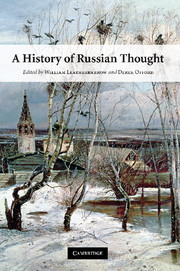Book contents
- Frontmatter
- Contents
- Preface
- List of contributors
- Dates, transliteration and other conventions
- Dates of reigns
- Russian titles of journals, newspapers and miscellanies
- PART I CONTEXT
- PART II INTELLECTUAL CURRENTS
- PART III THEMES AND CONSTRUCTS
- PART IV THE AFTERLIFE OF CLASSICAL THOUGHT
- Biographical details of thinkers and writers
- Selected bibliography
- Index
Preface
Published online by Cambridge University Press: 05 June 2012
- Frontmatter
- Contents
- Preface
- List of contributors
- Dates, transliteration and other conventions
- Dates of reigns
- Russian titles of journals, newspapers and miscellanies
- PART I CONTEXT
- PART II INTELLECTUAL CURRENTS
- PART III THEMES AND CONSTRUCTS
- PART IV THE AFTERLIFE OF CLASSICAL THOUGHT
- Biographical details of thinkers and writers
- Selected bibliography
- Index
Summary
Savrasov's famous painting The Rooks have Returned, which appears on the cover of this volume, was felt by the painter's contemporaries to convey an authentic, quintessential Russianness. Kramskoy, leader of the so-called peredvizhniki, a group of painters who chose subject-matter that they perceived to be of national significance, singled the painting out for special praise when it was displayed in 1871 at the group's first exhibition, on account of its possession of ‘soul’ (dusha). The birches in the foreground, to which the rooks have returned to build their nests as snow melts and nature's annual renewal begins; the as yet bleak landscape stretching into a boundless distance under the weak sun of early spring; the meandering river; the ramshackle signs of human habitation in the rural vastness, including the wooden hut from which a wisp of smoke is rising; and – at the painting's centre – the symbols of the Russian people's religiosity, the church's belfry and the onion-shaped domes: these images depict Russia's heartland with a simple lyricism that seemed peculiarly appropriate to a section of the cultural elite at that juncture in her history. They poignantly evoked one aspect of a nation that was reappraising its position in the contemporary world and striving to define its distinctive character.
And yet it was a far cry, as every educated viewer of the painting would have been aware, from a village near Kostroma in the Golden Ring of ancient towns around Moscow, where Savrasov's landscape was located, to the Baroque and Classical splendour of the modern capital city, St Petersburg.
- Type
- Chapter
- Information
- A History of Russian Thought , pp. vii - xPublisher: Cambridge University PressPrint publication year: 2010



